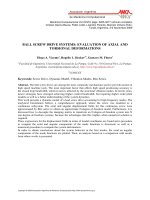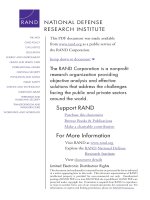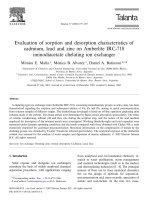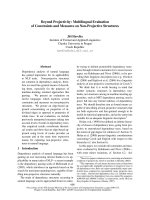Evaluation of Novel and Conventional Acaricides against Yellow Mite, Polyphagotarsonemus latus (Banks) on Chilli and their Effect on Prevailing Natural Enemies, Amblyseius sp. in Varanasi
Bạn đang xem bản rút gọn của tài liệu. Xem và tải ngay bản đầy đủ của tài liệu tại đây (188.32 KB, 7 trang )
Int.J.Curr.Microbiol.App.Sci (2017) 6(5): 2538-2544
International Journal of Current Microbiology and Applied Sciences
ISSN: 2319-7706 Volume 6 Number 5 (2017) pp. 2538-2544
Journal homepage:
Original Research Article
/>
Evaluation of Novel and Conventional Acaricides against Yellow Mite,
Polyphagotarsonemus latus (Banks) on Chilli and their Effect on Prevailing
Natural Enemies, Amblyseius sp. in Varanasi Region
A.P. Singh, Sandeep Kumar Sathua* and R.N. Singh
Department of Entomology and Agricultural Zoology, Institute of Agricultural Sciences,
Banaras Hindu University, Varanasi- 221005, India
*Corresponding author
ABSTRACT
Keywords
Yellow mite,
Amblyseius sp.,
novel acaricides,
chilli
Article Info
Accepted:
25 April 2017
Available Online:
10 May 2017
Eleven acaricides including one control, were evaluated at field condition
on the chilli yellow mite and on its natural enemies Amblyseius sp. in
Varanasi, U. P. The numbers of yellow mites were recorded in 1 cm2 area
at four spots on 30 leaves per treatments at 1, 3, 7 and 14 days interval after
the spray and the predatory mite populations were counted on weekly
interval after spray. Among treatments, Abamectin recorded highest yellow
mite mortality with 89.94%, followed by Diafenthiuron (82.27%) and
Milbemectin (77.27%). In case of the predator Amblyseius sp., cent percent
mortality was seen by Fenzaquin10 EC, followed by Ethion 50 EC. The
pesticides like Diafenthiuron 50 SC (3.02), Sulphur 80 WP and
Azadirachtin 10000 PPM were proved to be safer to Amblyseius sp., so
could be recommended for use in integrated chilli mite pest management
practices.
Introduction
Yellow mite, Polyphagotarsonemus latus
(Banks) (Acari; Tarsonemidae) represent
economically important pests of chilli in
greenhouses and crop fields all over the
world. Chilli is leading vegetable as well as
important commercial spice crops of India.
The Yellow mite, Polyphagotarsonemus latus
(Banks) (Acari; Tarsonemidae) is a wellknown agricultural pest of chilli crop. It is the
most injurious polyphagous pest infesting
chilli crop in the field at its multiple stages.
Yellow mite is difficult to control with
pesticides due to inaccessibility of lower leaf
surfaces, short life cycle, high reproductive
capacity and ability to develop resistance to
acaricides.
Chilli occupies the first position among the
spices produced in India, with a production
share of 30% under main spices in India.
Chilli is cultivated in 775 thousand hectare
with total production of chilli is 1482
thousand metric ton and productivity of chilli
is 1.9 million ton per hectare (Data base-2014,
2538
Int.J.Curr.Microbiol.App.Sci (2017) 6(5): 2538-2544
National Horticulture Board). Heavy menance
of pests is the major constraint in the
production and productivity of chilli.
Polyphagotarsonemus latus (Banks) may
even cause 100% loss under glass house
condition (Liu et al., 1991). Infestation by the
yellow mite during the early pre-flowering
stage culminates in the failure of ascending
flower bud and petiole. Incidence of Chilli
Yellow Mite is becoming very severe
particularly in Varanasi and Mirzapur district
in Uttar Pradesh of India. The oviposition
punctures inflicted by nymphalas well as
adult female might turn the plant fragile and
weak, causing premature falling to a tune of
10-90%, depending on the intensity of
devastation and management competence.
This destructive pest causes terminal leaves
and flower buds to become malformed. The
mite's toxic saliva causes twisted, hardened
and distorted growth in the terminal of the
plant (Baker, 1997). Mites are usually seen on
the newest leaves and small fruit. Leaves turn
downward and turn coppery or purplish.
Internodes shorten and the lateral buds break
more than normal. The blooms abort and
plant growth is stunted when large
populations are present (Denmark, 1980;
Wilkerson et al., 2005; Anonymous, 2010).
Pesticide residues are the major problems in
increasing our exports. Buyers expect a high
degree of hygiene and sanitation in processing
and preparation of chillies for export. The
consumers in importing countries insist on
‘clean spices’. This can be accomplished only
through an integrated approach with the
collective efforts of farmers, processors and
traders (Thamaraikannan et al., 2011). Due to
this notorious pest farmers are facing great
loss in there income in Varanasi and its
nearby regions of Uttar Pradesh. So this study
on chilli mite on chilli cultivar (KA-2) was
conducted, to study the infestation of this mite
and its comparative best management by
some novel and conventional pesticides.
Materials and Methods
Field experiments were conducted during
Kharif seasons of 2010-2012 in a randomized
block design with eleven treatments replicated
three times at the Institute of Agricultural
sciences, Banaras Hindu University, Varanasi.
The treatments included Diafenthiuron 50SC,
Abamectin 1.9 EC, Milbemectin 1EC,
Propargite 57 EC, Fenzaquin 10EC,
Fenpropathrin 30 EC, Dicofol 18.5EC, Ethion
50 EC, Sulphur 80WPand Azadirachtin 10000
PPM for foliar spray at fortnightly interval.
The mean per cent reduction data of yellow
mite was recorded at 1, 3, 7, and 14th days
after spraying of pesticides. Chilli variety
KA-2 was planted in plots of size 3m x 3m at
spacing of 30cm x 45cm with recommended
package of practices except other insecticidal
applications. Foliar application of pesticides
was done by hand compression sprayer, when
mite population was at pick.
The observations were recorded from five
plants selected from each plot those were
tagged and numbered. Two leaves were taken
from upper, middle and lower portion of the
tagged plants (total of 06 leaves) collected
from each plant and 30 leaves from each plot
and kept in a separate polythene bag and
brought the leaves in a laboratory. The
population comprised with alive adults and
nymphal stages of mites were counted with
the help of stereoscopic binocular microscope
on pretreatment, after 1, 3, and 7 and 14 days
of spraying in the treatment. The data of
reduction of mite population in field
experiments were calculated in to per cent
reduction by using following Abbot’s formula
(1925).
The per cent reductions in mite population at
various days were transformed in to Arc Sine
√percentage. The number of natural enemies,
Amblyseius sp was also counted like yellow
mite on 10 randomly selected plants as pre-
2539
Int.J.Curr.Microbiol.App.Sci (2017) 6(5): 2538-2544
treatment count and post-treatment count
(after 7 DAS). The treatment effect was
analysed by analysis of variance between
treatments and mite population with CD at
5% level of significance. All the statistical
analysis was performed by using the online
analysis programme OPSTAT.
Results and Discussion
Effect on Yellow mite (P. latus)
In the research conducted to judge the
bioefficacy of the novel pesticides against P.
latus and its predatory mite revealed that,
overall percent reduction increase mean of
two applications of chilli mite/leaf before
application of pesticides varied between
16.21-18.33. Pre-treatment counts of mite
made a day before first spray did not exhibit
significant variation in population among
different treatments. The results were
represented in Table-1 consist of mean
comparison of the data, regarding the
treatment effect on yellow mite population
and percent reduction, at different posttreatment intervals. It was noticed that during
first round of spraying maximum mortality in
mite population was showed in Abamectin 1.9
EC (62.58%), followed by Fenpropathrin
30EC (60.20%), Propargite 57 EC(60.00%),
the Milbemectin 1 EC (59.60%) and
Diafenthiuron 50 SC (58.12%) respectively.
Whereas Fenzaquin10 EC (46.72%) and
Dicofol 18.5 EC (46.03%) showed moderate
mean per cent reduction in mite population.
Ethion 50 EC (35.00%), Azadirachtin10000
PPM (17.36%) and Sulphur 80WP (12.79%)
poorly performed and showed less efficacy
against mite population.
After the third day of spraying, Abamectin1.9
EC showed mite reduction of (72.54%),
Diafenthiuron 50 SC (67.05%), and
Milbemectin1 EC (64.16%) and performed
very good with maximum reduction in mite
population (Table 1). The Propargite 57 EC
(62.44%), Fenpropathrin 30 EC (60.40%) and
Fenzaquin10 EC (47.93%) showed moderate
performance on mite population. Dicofol 18.5
EC (42.94%), Ethion 50 EC (38.17%),
Azadirachtin 10000 PPM (23.73%) and
Sulphur 80WP (17.36%) poorly performed
and showed less effect on mite population.
The Abamectin (76.31%), Diafenthiuron
(67.70%) and Fenpropathrin 30 EC (62.58%)
were given maximum mean per cent
reduction in mite population on the seventh
day of spraying. Moderate performance
showed in Milbemectin1 EC (61.96%),
Propargite 57 EC (59.93%), Fenzaquin10 EC
(48.62%), Dicofol 18.5 EC (44.26%), Ethion
50EC (46.26%), Azadirachtin10000 PPM
(17.36%) and Sulphur 80 WP (35.55%)
showed very less effect on mite population.
The Abamectin (77.48%), Diafenthiuron 50
SC (68.36%) and Milbemectin1 EC (60.40%),
were given maximum mean per cent
reduction in mite population on the 14th day
of spraying. Moderate performance showed in
Dicofol 18.5 EC (51.30%), Propargite
(50.18%), Ethion 50 EC (46.26%) and
Azadirachtin 10000 PPM (44.54%). The
Fenpropathrin 30 EC (41.50%), Sulphur 80%
WP (39.58%) and Fenzaquin 10 EC (37.88%)
showed poor effect on mite population.
Mean percent reduction over control in
pooled data of two spray both the years the
result showed that all the novel and
conventional acaricides were effective with
mean percent mortality in the range of 19.91
to 71.47 in first and second spray percent
mortality over control. Abamectin recorded
highest mortality with 62.58, 72.54, 76.31 and
77.48 percent after 1, 3, 7 and 14 days after
spray and lowest protection was given by
sulphur with 12.79, 17.36, 35.55 and 39.58
percent mortality over control respectively.
2540
Int.J.Curr.Microbiol.App.Sci (2017) 6(5): 2538-2544
Table.1 Evaluation of novel and conventional acaricides against Yellow mite, P. latus (Banks) on chilli
Acaricides
Dose
Pre-spraying
mean population
per leaf
Diafenthiuron 50 SC
0.75 gm/lit
17.38
Abamectin 1.9 EC
0.70 ml/lit
16.21
Milbemectin 1 EC
0.75 ml/lit
18.33
Propargite 57 EC
2.0 ml/lit
16.76
Fenpropathrin 30 EC
0.5 ml/lit
16.56
Fenzaquin10 EC
2.0 ml/lit
16.49
Dicofol 18.5 EC
2.7 ml/lit
16.90
Ethion 50 EC
2.00 ml/lit
16.40
Sulphur 80 WP
3.12gm/Kg
16.51
Azadirachtin 10000 PPM
2.0 ml/lit
16.88
-
16.57
Control
(Water Spray)
SEM ±
*Mean per cent reduction in mite
population day after spraying
*Mean
1 DAS
72.11
(58.12)
78.89
(62.58)
74.47
(59.60)
75.01
(60.00)
75.39
(60.20)
46.72
(43.11)
51.82
(46.03)
32.90
(35.00)
4.98
(12.79)
8.95
(17.36)
1.84
(7. 71)
3 DAS
84.84
(67.05)
91.06
(72.54)
81.06
(64.16)
78.63
(62.44)
75.64
(60.40)
55.19
(47.93)
46.40
(42.94)
38.20
(38.17)
8.95
(17.36)
16.24
(23.73)
8.92
(17.36)
7 DAS
85.68
(67.70)
94.47
(76.31)
77.94
(61.96)
74.97
(59.93)
78.89
(62.58)
56.31
(48.62)
48.74
(44.26)
46.61
(43.05)
33.82
(35.55)
42.61
(40.74)
16.21
(23.73)
14 DAS
86.47
(68.36)
95.34
(77.48)
75.64
(60.40)
59.08
(50.18)
37.74
(37.88)
43.96
(41.50)
60.94
(51.30)
52.23
(46.26)
40.65
(39.58)
49.29
(44.54)
19.49
(26.13)
82.27
(65.05)
89.94
(71.47)
77.27
(61.48)
71.92
(57.99)
66.91
(54.88)
50.54
(45.29)
51.97
(46.09)
42.48
(40.63)
22.10
(28.04)
29.27
(32.71)
11.61
(19.91)
*Mean
Yield
(qt/ha)
% increase
in yield over
control
25.67
63.65
24.75
62.30
21.83
57.26
23.75
60.71
20.67
54.86
13.67
31.74
23.17
59.73
14.43
35.34
17.70
47.28
11.33
17.67
9.33
-
-
3.742
3.951
3.715
5.072
-
1.662
CD (0.05)
-
1.250
8.242
7.748
10.579
-
2.432
Significance
NS
S
S
S
S
*Mean of three replications, Values in the parenthesis were Acr-sine transformed
DAS- Days after spraying, S- Signifiant, NS- Nonsignifican
2541
S
Int.J.Curr.Microbiol.App.Sci (2017) 6(5): 2538-2544
Table.2 Effect of pesticides on the population of natural enemy, Amblyseius sp. (Pooled data of
Kharif, 2010- 11 and 2011-12)
Treatments
Dosage
(g
a.i/ha)
Diafenthiuron 50 SC
Abamectin 1.9 EC
Milbemectin 1 EC
Propargite 57 EC
Fenpropathrin 30 EC
Fenzaquin10 EC
Dicofol 18.5 EC
Ethion 50 EC
400
70
3.5
1000
100
1000
500
1000
Sulphur 80 WP
2500
Azadirachtin 10000
PPM
Control(Water Spray)
CD (0.05)
Significance
Dose
0.75 ml/lit
0.70 ml/lit
0.75 ml/lit
2.0 ml/lit
0.5ml/lit
2.0ml/lit
2.7 ml/lit
2.00ml/lit
3.12
gm/Kg
Pre-spraying
mean
population per
leaf
2.92
3.02
2.05
3.16
2.38
5.06
3.02
4.06
Population of
predatory mite
(Amblyseius sp.) /30
leaves
3.02
1.52
2.15
2.22
1.18
0
2.52
1.08
3.18
3.02
0.2%
2.0 ml/lit
3.19
2.83
-
-
3.20
0.18
NS
3.03
0.22
NS
NS- Non significant at 5% level of significance
Figure.1 Effect of various acaricides on the population of natural enemy, Amblyseius sp
The pesticides were ranked in the following
order based on their overall performance:
Sulphur 80 WP
Effect of pesticides on yield of chilli
The per cent increase in yield over control in the
plots treated with of Diafenthiuron was
(63.65%) 25.67qt/ha followed by Abamectin
(62.30%) 24.75 qt/ha, Propargite (60.71%)
23.75 qt/ha, Dicofol (59.73%)23.17 qt/ha,
2542
Int.J.Curr.Microbiol.App.Sci (2017) 6(5): 2538-2544
Milbemectin
(57.26%)
21.83
qt
/ha,
Fenpropathrin (54.86%) 20.67 qt /ha, Sulphur
80 WP (47.28%) 17.70 qt /ha and Azadirachtin
10000 PPM (31.74%)13.67 qt /ha. The least
increase in yield of chilli was found in the plots
were treated with of Fenzaquin (2.0ml/lt) gave
11.33 qt/ha (17.67%) (Table1). Gundannavar et
al., (2007) studied that Diafenthiuron (0.75 g/lt)
gave the highest yield in case of chilli.
Effect on natural enemy (Amblyseius sp.)
The data on the population of predatorymite
Amblyseius sp. was presented in Table 2 which
shows that the population of predatory mite in
different treatments varied significantly among
themselves at 7 days after treatment. Among the
different treatments, the maximum number of
predatory mite were recorded from untreated
control plots (3.03 Amblyseius sp./ 30 leaves)
followed by Dicofol 18.5 EC and Diafenthiuron
50 SC with 3.02 Amblyseius sp./30 leaves
remained at par with each other and with
Azadirachtin 10000 PPM (2.83 Amblyseius sp.
/30 leaves/plot) (Table 2 & Fig 1). There was no
predatory mite recorded in Fenzaquin10 EC @
1000 g a.i. /ha (30 leaves/plot). It was revealed
from the experiment that though the Amblyseius
sp. population was affected by application of
the pesticides but the population was found to
be least affected by application of Abamectin
1.9 EC @ 70 g a.i./ha with 3.02 and 1.52/ 30
leaves).
All the acaracides were effective in reducing the
population over control with percent reduction
of 71.47 (Abamectin) to 28.04 (Sulphur). The
performance of Diafenthiuron, Milbemectin,
Propargite and Fenpropathrin showed similar
trend with 65.05%, 61.48%, 57.99% and
54.88% respectively. The treatments behaved in
similar manner 7 and 14 days after spray with
minimum percent reduction of mite population
over control recorded by Ethion, Azadirachtin,
Sulphur (40.63, 32.71 and 28.04%) and
maximum by Abamectin (71.47%) followed by
Diafenthiuron
(65.05%),
Milbemectin
(61.48%), Propargite (57.99%), Fenpropathrin
(54.88%) and Dicofol (46.09%). The result of
the same trend also has been recorded during
second and third round of spraying. Present
findings regarding efficacy of Abamectin1.9EC
@ 70 g a.i. /ha against Polyphagotarsonemus
latus (Banks) are in conformity with the study
of Srinivasulu et al., (2002) and Nayak et al.,
(2010). Higher mortality of yellow mite was
observed in Abamectin 1.9 EC @ 70 g a.i. /ha
after 14 days of application during two
consecutive years, respectively whereas
Diafenthiuron proved to be at par effective was
reported by Patel et al., (2010). The toxicity of
different treatment against the predatory mite
has been presented in Table- 2. The treated
dosages Abamectin 1.9 EC, Diafenthiuron 50
SC and Ethion 50 EC have got very low to
moderate impact on predatory fauna of
Amblyseius sp. Only fenazaquin 10EC was
unsafe, reducing population of predators up to
100 % (Fig.1). Hence, from this part of study, it
can be concluded that, Sulphur 80 WP at 2500 g
a.i. /ha, Diafenthiuron 50 SC at 400 and
Azadirachtin 10000 PPM at 0.2 % were safe for
the predatory mite in chilli eco-system.
Conservation and release of native predatory
mites if available also can minimize the mite
populations from the field. Amblyseius sp. Is an
efficient predatory mite, which regulates the
pest under field conditions. The acaricides viz.
Diafenthiuron, Abamectin and Propargite were
found to enhance the fruit yield of chilli, in
addition to reduction of mite population.
In conclusion, it is evident from this studies that
three rounds of sprays of Abamectin 1.9 EC @
70 g a.i. /ha, Diafenthiuron 50 SC @ 400 ga.i.
/ha, Milbemectin 1 EC@ 3.5 g a.i. /ha gave
excellent control of Chill Yellow mite,
Polyphagotarsonemus latus Banks. The
pesticide was moderately toxic to natural
enemies & did not produce any phytotoxic
symptoms on chilli fruits and plants. In addition
to this, they also have effect on increasing the
fruit yield of chilli in comparison to the
untreated plots. Considering the limitations of
chemicals in management of chilli mite in large
perspective selective control measures are very
important aspect for successful chilli
cultivation.
So,
the
chemicals
like
2543
Int.J.Curr.Microbiol.App.Sci (2017) 6(5): 2538-2544
Diafenthiuron 50 SC @ 400 ga.i. /ha,
Milbemectin 1 EC @ 3.5 g a.i. /ha, Abamectin
1.9 EC @ 70 g a.i. /ha could be recommended
to farmers for successful management of yellow
mite incidence in chilli crop.
Acknowledgement
The researchers are thankful to The Head,
Department of Entomology & Agril. Zoology of
Institute of Agril. Sciences, BHU for providing
the necessary experimental helps and laboratory
facilities.
References
Abbott, W.S. 1925. A method of computing the
effectiveness of an insecticide. J. Economic
Entomol., 18: 265-267.
Anonymous. 2010. Vegetable Protection,
Population dynamics of chilli thrips and
mites, Data base (2014) National
Horticulture Board, Pp-6 (1- 286).
Baker, J.R. 1997. Cyclamen mite and broad mite.
Ornamental and Turf Insect Information
Notes.
Denmark,
H.A.
1980.
Broad
mite,
Polyphagotarsonemus
latus
(Banks).
FDACSDPI Bureau of Entomology
Circular No. 213: 1-2.
Gundannavar, K.P., Giraddi R.S., Kulkarni K.A.
and Awaknavar, J.S. 2007. Development of
Integrated Pest Management modules for
chilli pests. Karnataka J. Agric. Sci., 20:
757-760.
Kulkarni, G.S. 1922. The ‘Murda’ disease of chilli
(Capsicum). Agric. J. India, 22(1): 51-54.
Liu, T.S., Wang, W.J and Wong, Y.S. 1991.
Survey on the hosts damaged by the broad
mite and its control. Plant Prot. Bull.,
33(4): 344 – 353.
Nayak, U.S., Baral, K and Senapati, S.K. 2010.
Efficacy of certain acaricides against chilli
mite P. latus, International Symposium cum
Workshop in Acarology, 95.
Patel, L.C., Mondal, B., Mondal, C.K., Mondal,
P., Karmakar, K and Roy, S.K. 2010.
Management of leaf curl complex - A
Malady for Summer Chilli of Sundarban
Region of West Bengal, Abst, International
symposium cum workshop in acarology,
BCKV, Kalyani, West Bengal, 98: 8-10
April.
Rai, A.B., Satpathy, S., Gandhi, Gracy R.,
Swamy, T.M.S and Rai, Mathura. 2007.
Yellow mite Polyphagotarsonemus latus
(Banks) menace in chilli crop. Veg. Sci.,
34(1): 1-13.
Senapati, A.K., Maity, A.K. and Chatterjee, M.L.
2010. Effect of few new acaricides against
yellow mite of chilli, International
Symposium cum Workshop in Acarology
BCKV, 95p.
Solanki, V.Y. 1999. Ecolgy and cotrol of sucking
pest of chilli with special references to
Polyphagotarsonemus latus Banks (Acari:
Tarsonemidae), M.Sc Thesis, Gujrat
Agriculture University, Navsari, 174pp.
Srinivasulu, P., Naidu, V.G and Rao, N.V. 2002.
Evaluation of different pesticides for the
control
of
yellow
mite,
Polyphagotarsonemus latus (Banks) on
chilli. J. Appl. Zool. Researches, 13(1): 7172.
Thamaraikannan, M., Palaniappan, G and
Sengottuvel, C. 2011. Time to step up chilli
exports, Market Survey, Facts for you Sept
30-35.
How to cite this article:
Singh, A.P., Sandeep Kumar Sathua and Singh R.N. 2017. Evaluation of novel and conventional
acaricidesagainst Yellow mite, Polyphagotarsonemus latus (Banks) on chilli and their effect on
prevailing natural enemies, Amblyseius sp. in Varanasi region. Int.J.Curr.Microbiol.App.Sci. 6(5):
2538-2544. doi: />
2544









